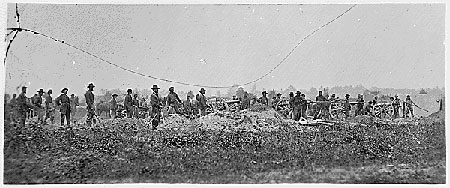
Shiloh / Pittsburg Landing
After the debacle at Fort Donelson, Confederate General Albert Johnston was bitterly criticized by the Southern people; so much so that he had offered the command to Beauregard, but the Creole general refused the responsibility.
Johnston revived his failing reputation and won the veneration of the Southern people at the Battle of Shiloh on April 6, 1862, a battle that was to claim his life.
After Johnstonís armies had passed through Nashville, he succeeded in the difficult operation of uniting his force with those under General Beauregard at Corinth in northeastern Mississippi. General Braxton Bragg arrived from Pensacola, providing further strength.
A little more than 20 miles to the northeast, a strong Union force under the command of General Ulysses Grant was at Pittsburg Landing, on the southwestern bank of the Tennessee River.
Landing on the southwestern bank of the river, Johnston decided, despite the fact that his 40,000 troops were poorly trained and ill equipped, to attack an advance division of Union troops before it could be reinforced by additional troops from Nashville.
Johnston adopted a plan of attack, drawn up by Beauregard, that consisted of placing one corps behind another in three long, thin lines, rather than advancing by columns.
The Confederate advance was so delayed by rain and muddy roads that Beauregard unsuccessfully urged a return to their base, convinced that all chance for a surprise had been lost.
The Confederate attack on Union troops under the command of General William Tecumseh Sherman proved to be a surprise, announced only by a reconnaissance force that encountered the Confederates without sufficient time for preparation.
General Grant was nine miles away at his headquarters at Savannah, on the other side of the river, when the battle began.
The gray army drove the Union troops from their camp and occupied Shermanís headquarters at the chapel of Shiloh. Rather than following up on the victory, however, many of the Southern soldiers stopped to plunder the camp.
Johnston had been directing the operations on the right of his line, leaving the general direction of the battle to Beauregard. At about 2:30 in the afternoon, he was struck by a Minie ball which severed an artery in his leg. While the wound would likely not have been mortal, he remained in the saddle until he bled to death.
The Confederates drove the Union troops, fighting bravely, nearly to the river; but having used up their reserves earlier in the day, they lacked sufficient strength to complete their victory. Beauregard, who had been ill, put a halt to the fighting at about 6:00 p.m.
The Confederate troops were poorly equipped and fatigued, having fought for 12 hours without food or rest.
Thus it was that with the arrival of Buellís Union troops, late in the afternoon and during the night, the tide of the battle was turned. While the Confederates renewed their attack the following day, they no longer had the advantage.
While able to stop the Union advance, but did not break its battle line. Realizing that he couldnít win and having suffered too many casualties, Beauregard retired from the field and returned to Corinth, a strategic railroad center in northern Mississippi.
Although the Union lost more men at Shiloh than did the Confederacy, the Southern losses accounted for an equivalent of a quarter of its entire strength, the Confederate retreat left the Union in position to move on Corinth, and the battle was considered a win for the Union.
 |